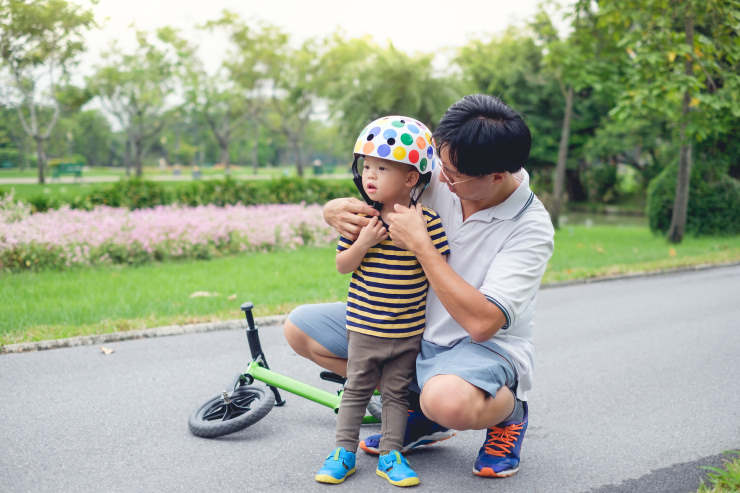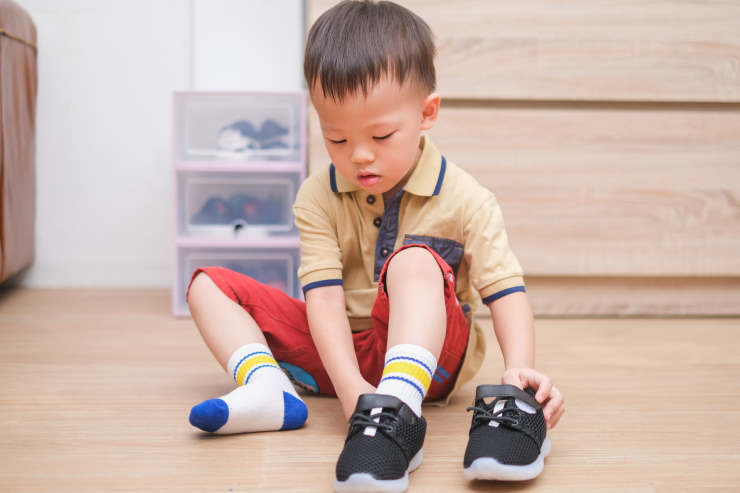Introduction
They say having a baby completely changes things. And they are not wrong because starting from the day you get pregnant, your emotions, body, and life start to change rapidly as your baby develops. As a matter of fact, starting from the day your baby is born, you will witness how they change and develop daily. These changes, while first mostly physical and verbal, eventually will turn into intellectual and cognitive.
And these changes that every baby goes through are referred to as a baby’s developmental milestones. As parents, for you to be able to observe, witness, and understand these changes, you need to know what each milestone brings and means very well because not being informed about all of these might cause you to miss out on them, or worse, being unable to notice developmental failures.
This is why today we will be talking about a baby’s developmental milestones and examining the stages of child development. However, before we start, we should be reminded that every baby is different, which means that it’s perfectly normal for your baby to acquire an ability earlier or later than other babies. Of course, if you think there’s a problem with your baby’s development, you should always consult your pediatrician.
5 Stages of Baby Development

The five stages of baby development start with the newborn stage. At this stage, which lasts until your baby is 3 months old, babies respond to outside stimuli naturally. So, you might see them smiling back at you or trying to describe their need for you by crying and screaming.
As your baby moves into the infant stage, which is expected between 3 and 12 months, you might witness them recognizing familiar faces and starting to babble. And as they near the 6th and 9th-month mark, babies should be able to sit without support, respond to their names, the point at things they want you to see, and imitate your words and mimics.
Toddler stage, which falls between the ages of 1 and 3, your baby should be able to stand on their feet without help, walk and even run. Also, at this stage, it’s expected for kids to be able to acknowledge simple instructions. After a kid is over 3 years old, you can expect their motor skills to get refined, which means they can start dressing themselves and going to the toilet alone.

At the last stage of their growth, when they are 5 or 6, also known as the school age, kids start to gain independence. This means they will have their own opinions, experience a range of emotions, and start to form bonds with others around them. This stage is expected to last until they are 15 to 17 when they hit puberty.
And at each one of these stages, you can observe your baby gaining skills in four main fields. These fields include the cognitive field, which is related to greater intelligence, social and emotional field, in which they gain social skills, the physical field, which is related to kids’ motor development; and the communication and speech field.
What Is a Developmental Milestone Checklist?

A developmental milestone checklist is a guide that helps health professionals and parents track a baby’s developmental milestones. This checklist shows what skills should be gained at certain ages. Because if your child is at a certain age and still lacking some skills, this might be a sign of an important development failure. However, getting help from this checklist might help you notice certain problems promptly.
With a developmental milestone checklist, you can track your baby’s development from 2 months to 5 years. Of course, checklist items change as your baby grows old. For example, for a 0-3 months old baby, the milestone checklist includes the motor, sensory, communication, and feeding titles. And while one of the items under the communication title for 0-3 months olds is making eye contact, for 4-6 months olds, you can see an item about listening and responding.

Monitoring your baby’s development with the help of a checklist is highly crucial since it can help you learn how to spot developmental issues in kids. And by noticing the problems at an early stage, you can better understand your child’s needs and provide them with the right sources. However, it should be remembered that these checklists are only for tracking your baby’s development. And if you think there’s an issue, you should consult your pediatrician.
With that being said, it should be noted that the age ranges in these guides are just average ages provided by health professionals. And according to them, every child is different, and it’s natural for some to develop certain skills later than their peers. Also, if your baby was born premature, note that these checklist items won’t apply to them. So, even though keeping track is important, diagnoses should be left to professionals.
What Do Babies Do at Certain Ages?

The majority of a baby’s activity during the first month after birth is reflexive, which means that their responses are automatic. Afterward, as the nervous system develops, newborns gain the ability to give their actions more consideration. So, what should be expected at what age? Between 0-3 months, you can observe your baby smiling. However, this is not a reactive smile but a self-smile.
Also, at this age, your baby should be able to keep their attention on the target, open and close their hands, hold things firmly, and even attempt to grab objects. After hitting the 4 months mark, you can observe your baby interacting with the environment and getting good at using their hands. This is also where babies are expected to start babbling, laughing, and controlling their heads with ease.

After six months is when babies get active. You can see them crawling, scooting, and sitting without needing support. And at this stage of their life, until they are 9-10 months old, they should be able to react to words they recognize, like their names and everyday words. Most major changes, however, come between the 10th and 12th months. This is when you can hear your baby calling you “mama” or “dada.”
At this stage, your baby should be able to eat alone, stand on their feet without any support or help, walk by supporting themselves with the furniture, demand stuff by pointing at them, climb without support, and understand short instructions. Furthermore, you might notice your baby starting to pretend by trying to do what you do, like putting their toys in order or preparing food with their toys.
4 Stages of Piaget’s Development

As grown-ups who have already figured out the basics of everyday actions, sometimes it might be hard for us to fathom why kids make the same mistake again and again. However, Swiss psychologist and philosopher Jean Piaget’s study on child development clearly explains kids’ cognitive processes and provides parents and caregivers with a more realistic point of view. According to Piaget’s cognitive development theory, a child goes through 4 different learning stages.
This means a child’s behavior can only change as their cognitive abilities advance to the next stage. According to his idea, the stages are sequential, and each stage merely follows the one before it. So, what are these stages? The sensorimotor stage is between 0-2 years old, the preoperational stage is between 2-7 years old, the concrete operational stage is between 7 and 11 years old, and lastly, the formal operational stage, which lasts until they are adults.

Newborns and toddlers learn only through sensory interactions since they are only at the start of their cognitive development. So, in this stage, their whole experience is mediated by fundamental reflexes and motor functions. In the preoperational stage, the child acquires language. And even though they start learning through play, they still find it hard to fathom others’ perspectives. The concrete operational stage is when they get better at applying logic while still being highly literal in their perception.
Although they start to understand the point of view difference in other people, it’s still normal for them to have trouble understanding hypothetical and conceptual notions at this stage. And lastly, the formal operational stage. According to Piaget, this is when a solid improvement in logic, the capacity for deductive reasoning, and a grasp of abstract concepts occur. At this stage, your child can now identify possible answers to issues and begin to approach their surroundings with a more scientific mindset.
4 Stages of Vygotsky’s Cognitive Development

Lev Vygotsky, a psychologist and theorist from the Russian Empire, was born in 1896 and published six books in 37 years. And although his work wasn’t well recognized in Western nations until the 1970s, it has subsequently come to be recognized as some of the key ideas in developmental psychology. According to Vygotsky’s theory, cognitive and social development are intricately intertwined. So, what does that mean?
It means that culture significantly influences the establishment and growth of particular skills in children, such as learning, memory, attention, and problem-solving, and group activity, social connection, and language are essential for early learning.
This theory consists of 4 stages: assisted performance, unassisted performance, full internalization, and de-automization. The assisted stage is when the child is first discovering a new ability or subject and needs assistance from someone with more expertise than themselves.

The child who receives assistance learns using a variety of teaching techniques, such as lectures, problem-solving activities, and social feedback. Then, they move to the second stage, where they master new abilities and complete chores independently. The child may not yet have mastered the task, but she is now self-assured enough to complete it on their own. Due to the child’s incapacity, the second stage is still regarded as a beginning stage.
The third stage occurs when a student reaches the point at which performance is completely established and automatic. At this point, uncertainties are gone, and they have assimilated the abilities required to complete the activity competently. The child reaches the fourth and final stage, typically in their adult years. At this point, they no longer possess the skills required to execute at a proficient level. Of course, de-automization requires unexpected events such as sudden trauma and personal crises.
Conclusion

Now that you have a better understanding of a baby’s developmental milestones, you can help your kid’s development. As you can see, they are just learning and should be allowed to make mistakes in this process. Otherwise, they will never be able to comprehend what is what fully. With that being said, if you observe your child falling behind on these milestones, it’s crucial to consult a pediatrician as soon as possible.
Early detection and intervention are crucial because a baby’s early years are among the most crucial for its development. Then again, keep in mind that every individual is unique and that milestones usually happen within a broad age range. And mostly, even if there is a delay in development, these will be temporary. If your baby is not premature or has any other health conditions, you probably have nothing to worry about.




